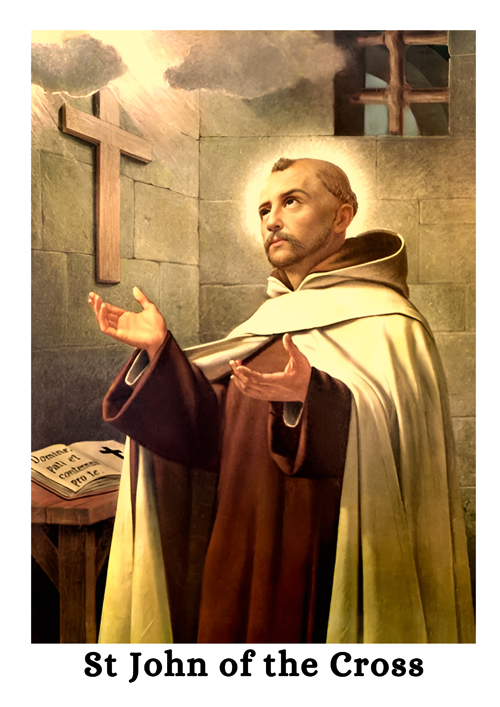O living flame of love
That tenderly wounds my soul
In its deepest center!
Since now you are not oppressive,
now consummate! if it be your will:
tear through the veil of this sweet encounter!
In the 16 th century, Juan de Yepes Alvarez could see the living flames of love, in the example of his father Gonzalo de Yepes and his mother Catalina Alvarez, what it means to sacrifice all for the sake of true love.
His family fostered piety, and John treasured such attitudes throughout his life, especially his devotion to Mary.
One of John’s favorite images for communicating union with God is that of fire burning. The symbol of fire is central to Moses’ encounter with God at the burning bush. In the New Testament, Jesus used the symbol of fire to describe his passionate desire to establish his kingdom: “I have come to bring fire on the earth and how I wish it were blazing already!”. The symbol of fire is also for the Holy Spirit at Pentecost, where the spirit of Jesus would continue to blaze out through the Church and into the world. One of the major writings of St. John of the Cross is the Living Flame of Love, speaks about the universal human experience of God.
First, he teaches that the love of God exists before us, whether we accept it or reject it. God is the one who loves first, who created us in love and for love. And so, God is always the first lover, the perfect lover and the source of all love. It precedes us and burns before us. As John explains, the Holy Spirit is “an infinite fire of love… that surpasses all the fires of the world”.
Second, this love of God is not static but goes in search of the Beloved: “In the first place, it should be known that if anyone is seeking God, the Beloved is seeking that person much more”. Where God is concerned, “love is never idle; it is in continuous movement”. God engages us with his probing love and woos us through what John calls spiritual affection: “Through spiritual affection God refreshes, delights, and gladdens the soul”.
Third, when God’s love finds us, it is not content to encounter us and leave us outside itself. Like two lovers who meet and whose first reaction is to embrace, so the love of the Trinity opens out before us, embracing us and enfolding us within God’s very life.
The fourth, the perennial intimacy and joy of communion with God in Christ Jesus, will be our wealth to share with others. St John teaches: “Contemplation is nothing but a hidden, peaceful, loving inflow of God, which, if not hampered, fires the soul in the spirit of love”.
Fifth, the purgative process reaches its climax when we become completely united to his divine life, burn gently, and rest within himself. Because loving another means allowing them to be themselves, God’s love does not dissolve us into itself. The closest we come to understand this consummation in love is with the marriage of a bride and groom and the consummation of their love. God is the Bridegroom and his people are the bride. Consistent with Scripture, John prays, “May the sweetest Jesus, Bridegroom of faithful souls, be pleased to bring all who invoke his name to this marriage”.
Lastly, the fruits of this bridal union with God are abundant and show themselves in human lives—remarkable delight, cooperation with God’s grace. The beauty of God enraptures our soul as we begin to resemble the goodness and beauty of the One who loves us: “This beauty is always vibrant for the soul and is like a song that is new, of great jubilation.
St John of the Cross prophetically calls generations to follow the path he took. However, John’s quest for authenticity resonates with the hopes of modern men and women. Through all his struggles, he maintains the right priorities and proves that living the flames of love is possible under any circumstances. A man of wisdom, who has journeyed to the mountaintop and will guide us to live the flames of love in this 21 st century.
















